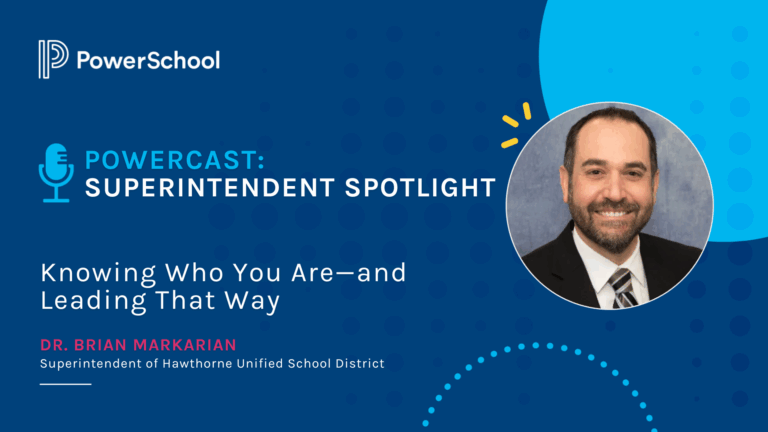A former National Distinguished Principal honoree and longtime Los Angeles USD site leader shares the core values that build relationships and teams dedicated to continuous improvement.
By Angel Barrett
A positive school culture is not a random act; the principal sets the tone through conscious and deliberate planning and reflection on implementing core values. In order to be successful, principals must be able to not only identify but also articulate their own core values. Here is the way I have organized mine.
Core Value #1: Every person is important and welcome.
For an administrator, this value begins with being present: Be outside, be at the gates and welcome people by name. Welcome everyone with a smile. Build relationships.
The most important thing that an administrator can do to build relationships is to listen. When starting a new position, I post a schedule and begin a conversation with everyone on site. Three easy questions to begin the conversation are: 1) What do you think are the strengths of this school/office, 2) If given a magic wand, what is the first thing that you would change, and 3) What do you want me to know? These questions also work for the beginning of the school year when helping teachers establish an individualized learning plan for themselves.
Annually, my staff and I debrief current policies to ensure that the policies truly value each person and the role that they play. For example, in many schools, students who are punished are assigned to help the plant manager. In other words, if you are punished, you will be forced to keep the school clean. The plant manager’s job is punishment; no one really wants to do it. Are these the messages we want to send students?
At Stagg St. Elementary School, we have students volunteering to keep the school clean, and they receive community service tickets. At the end of the month there are drawings for prizes.
And, for students who vandalize or make a mess, they have to take responsibility for their actions. They are held accountable for cleaning up the mess, and may also need to repay their debt to the school through community service. Students understand that by creating the extra work, they have disrespected the plant manager, and now they need to take responsibility for their actions. We have the same consequence with a different message and value.
While a mission or belief may be written on some dusty document in a file cabinet, the focus defines what we are doing. I often include the focus at the top of a meeting agenda, then have participants choral read them and turn to a partner and share what they saw at school this week that exhibits one or more of the foci.
For a school struggling with systems, here are the three foci you can use:
- Instruction is our highest priority.
- Everyone supports the instructional program.
- When students are not succeeding, we come together as a team to discuss how we can support the students.
For my current school, which is a good school moving to great, we adapted the definition of professional learning communities from “Leaders of Learning” by DuFour and Marzano.
- The fundamental purpose of Stagg St. ES is to ensure that all students learn at high levels.
- In order to help students learn, we must work collaboratively in a collective effort to meet the needs of each student.
- Outcomes matter: Stagg St. must implement a results orientation in order to know if students are learning and to respond appropriately to their needs.
Core Value #2: We all work as a team with a clearly identified focus.
Without clear focus, management is like herding cats or kindergarteners; leadership is identifying, reiterating and maintaining that focus.
At the beginning of each school year, we revisit the school’s focus. Sometimes teachers do a quick write to describe what each point looks like in action. Sometimes I use the fox and the hedgehog from “Good to Great” (Collins, 2001). We identify distractors (fox) that we need to stop doing and things we need to keep or implement to support our focus (hedgehog).
For leaders, “The Adaptive School: A Sourcebook for Developing Collaborative Groups” (Garmston and Wellman, 2009) has more than 100 strategies for information processing, including decision making, facilitator moves and inclusion.
With all of the instructional changes, professional development can easily become a fox. To ensure that professional development remains a hedgehog, leaders need to focus on structure and content.
Structure
- Instructional leadership team (ILT): Leaders cannot be experts in all areas, so build capacity in grade and department leaders.
- Emphasize PLCs not grade or department meetings. PLCs are focused. In reviewing DuFour’s and Marzano’s definition of a PLC, listed in core value #1, they are qualitatively different from a grade level meeting. I put the definition at the top of each agenda. ILT members then send me minutes from their PLC. I also list our accountability benchmarks directly below the PLC definition, so that PLC meetings are focused on specific, measurable goals.
- Strategies: In addition to engagement strategies listed earlier, I model the same strategies I expect to see in the classroom. Specifically plan the content delivery using communication guides, teaching philosophy statements (TPS), writing across the curriculum, and graphic organizers.
- Differentiate with blended learning: I choose a few exemplary sites and create hyperlinks. These methods allow PLCs choices in content and mastering the content with flexible time.
Content
- Make explicit connections between data and content. (PLCs identify specific data that they are using; often they directly tie the PLC work into Title I or district benchmarks.)
- Choose a focus for professional development. With all the initiatives, it is easy to become trapped in drive-by PD. Without a strong focus, there are many foxes waiting for your attention. Here is an example of our school’s three-year PD plan:
- Year 1 – English language arts/English language development framework, backwards planning using the standards and interim assessments, math fluency.
- Year 2 – Constructive conversations (ELD) and Math Claim #2, problem solving, and Math Claim #3, communicating, reasoning.
- Year 3 – Math Claim #4, modeling and data analysis, Next Generation Science Standards and project-based learning.
Adjunct committees are often major foxes. We all know there are things that must be done, whether it is the Winter Holiday Show or the school safety plan. However, how do these things fit into our focus, as opposed to sidetracking a school?
At Plummer ES, we had four standing committees: Safety, Technology, Community Events and Awards. At Stagg St. ES, we have three standing adjunct teams aligned to our values: Technology, Community Building, and School Climate and Culture. This year, we are changing technology to STEAM. Note that we also changed the name from Safety to School Culture and Climate as well as from committees to teams.
Another fox is the amount of time spent on discipline. Discipline happens when management fails. When students and staff are clear on expectations, most will rise and exceed expectations. Everyone wants to be successful. Here are some simple steps to turn the fox into a hedgehog:
- Clear communication between parent, teacher and administrator.
- Focus on better choices not punishment.
- Be preventative. At recess and lunch, are students engaged or wandering? If playing games, do they know the rules? Most problems arise because 1) students are bored, 2) they don’t want to play, or 3) they don’t have the social or physical skills to play.
When I had a full-time counselor, she would run a “bully” intervention on Monday, Wednesday and Friday by having students play in a small group and helping them to resolve conflicts. On Tuesday and Thursday, she worked with those who are typically bullied by using a small group to teach specific playground skills and how to find their own voices. As a single site administrator, I often do the same or ask a supervision aide to work with a small group.
When students are not successful, I keep everyone in the communication loop by having students write three simple statements:
1. This is my mistake:
2. This is why it was wrong:
3. This is what I learned to do better next time:
Teacher, parent and administrator all sign the paper, and it is kept on file.
My favorite time of day is supervision. Being a principal, I am so lucky that I get to have twice as much recess and lunch as anybody else. I love my time with my students. Supervision is a great time to teach social skills and prevent problems.
One of my pet peeves was always tattling, until a wise person taught me that students are trying to process their own concept of right and wrong and what needs to be done. Tattling is their form of testing their theories.
Core Value #3: We all model continuous learning.
Richard Elmore notes that if we want someone to do something, then it is our responsibility to ensure that they have the tools to be successful.
Given all the demands on teachers, it is easy to get overwhelmed. Not only is PD focus important but also highly structured planning. Our district provides for Tuesday banked time and three staff meetings a year. I organize an annual calendar as follows for each month: 1) first Tuesday is two hours concentrated PD (banked time plus staff meeting), 2) Flipped bank time: Adjunct Teams Meeting (staff meeting) plus PLC (banked time), 3) PLC plus staff meeting and 4) PLC.
In this way, teachers know that the first three weeks will be two-hour meetings. Most of the first week two-hour PD block and the staff meeting on week three are also given to PLCs.
Since all teachers have the primary sources hyperlinked at the beginning of the school year, the ILT members can plan professional development around their teachers’ learning needs and assessment calendars. This transparency helps teachers make connections between professional developments and alignment to goals and accountability.
In addition to an instructional leadership team, another means of developing capacity is a “fishbowl.” Below is an example of an instructional fishbowl implemented at Plummer.
- Data is used to determine a focus, for example, determining the main idea. (Step 1 is normally determined during PLCs.)
- During a two-hour PD, one grade level models cognitively planning a lesson while sitting in a circle in the center of the room. The other grade levels are sitting around the outside of the circle taking notes on the process.
- After planning the lesson, the grade level then debriefs with observers and opens the discussion for questions.
- All grade levels then cognitively plan a lesson for their grade level to teach.
- One teacher from each grade level volunteers to demonstrate the lesson the grade level developed for all teachers released to observe the demonstration. (Steps 2-5 occur during the two-hour meeting.)
- At each grade level meeting, one teacher demonstrates the lesson with his/her class. The other teachers from the grade level observe the lesson and take notes.
- The students then go out to the yard, while all teachers debrief the lesson they observed. The lesson is then revised, as needed. (Steps 6 and 7 occur during a grade level meeting with teachers released.)
- All teachers at the grade level teach the lesson in their classrooms.
Using this method focused on the comprehension skills of making inferences and drawing conclusions, our fourth grade students raised proficiency by 20 percent on the unit tests and by 18 percent on the California Standards Test.
At other schools, I have also used the fishbowl method to support teacher learning on classroom management and discipline. I would have four or five people, sometimes including district experts, sit in the fishbowl. We would take office referrals and discuss 1) which ones needed to be sent to the office, 2) which ones can be handled in the classroom, and 3) which ones we needed to modify or reinforce rules and procedures to prevent. We would then give suggestions for prevention and/or handling in the classroom.
Feedback is important to implementation. Too often feedback is provided only through evaluation or for struggling teachers. In a system of continual growth, feedback is given to all teachers on a regular basis.
I walk through classrooms two to three times a week. I mark the time block on my calendar just as I would any other important meeting. This method helps me provide a concentrated block to ensure I am in classrooms and minimize any disruptions. It also lets my office know when I will be back to return messages.
I establish an annual observations folder in my e-mail files. I have already established an “Observations 17-18” folder. Before I go to the next classroom, I dictate two or three sentences into an e-mail on my phone with a Cc to myself.
The subject line is Teacher last name: observation and date; for example, Barrett: math observation 6/22/17. The teacher receives the note and it is in my observations file before entering the next classroom and when I meet with the teacher or do evaluations. The name allows an easy sort for teacher discussion and evaluation. The subject area allows me to look at common PD needs. The date allows me to see growth or lack of growth.
These observations notes can also be used to help teachers set objectives for their own individualized learning plan. Going back to the three-question conversation in Core Value #1, this conversation is not only a way to value our staff as individuals but to help them set their own goals for learning and growth each year, establishing not only an expectation for continued learning but also giving me feedback on how I can support them.
Implementing these values over the last 20 years, not only have I had the pleasure of being part of two fabulous school families, but also I have seen tremendous growth.
Plummer ES went from a school in program improvement with an API of 405 to a California Distinguished School with four years over 800. When I left, we had an API of 862.
After five years in the district offices, I have a new home; I have been at Stagg ES for two years. We have had double-digit SBAC growth each year in ELA and this year in math. Check our California Dashboard.
Resources:
Collins, Jim. (2001). “Good To Great.” Harper Collins Publishers, LLC. New York, NY.
DuFour, Richard and Marzano, Richard (2011). “Leaders of Learning: How District, School and Classroom Leaders Improve Student Achievement.” Solution Tree. Bloomingdale, Indiana.
Garmston, Robert J. and Wellman, Bruce M. (2009). “The Adaptive School: A Sourcebook for Developing Collaborative Groups.” (2009) Garmston. Christoper-Gorden Publishers Inc., Norwood, MA.
For 15 years, Angel Barrett was the principal of Plummer Elementary School in LAUSD. She is currently the principal of Stagg St. ES. She is a former National Distinguished Principal.





























